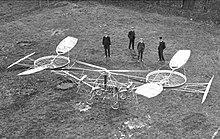Paul Cornu


Paul Cornu (June 15, 1881 – 6 June 1944) was a French engineer who manufactured bicycles by trade.
He was born at Glos-la-Ferrière, Orne.
Cornu designed the world's first manned rotary wing aircraft and made the first piloted free flight with it at Lisieux, Calvados, France on November 13, 1907. This first flight lifted Cornu about 30 cm (1 ft) and lasted 20 seconds. This is sometimes recognized as the first free (but impractical) helicopter flight with a passenger. This first helicopter was powered by a 24 horsepower (18 kW) Antoinette engine.[1]
The helicopter was not maneuverable however, and the construction was abandoned after a few flights.
Previously, another French helicopter, the Breguet-Richet Gyroplane I, had managed to lift off by its own power, but it had been held in position by men standing on the ground.
Comu died in 1944 in Lisieux, when his home was destroyed during the bombardment that accompanied the Normandy landings.
